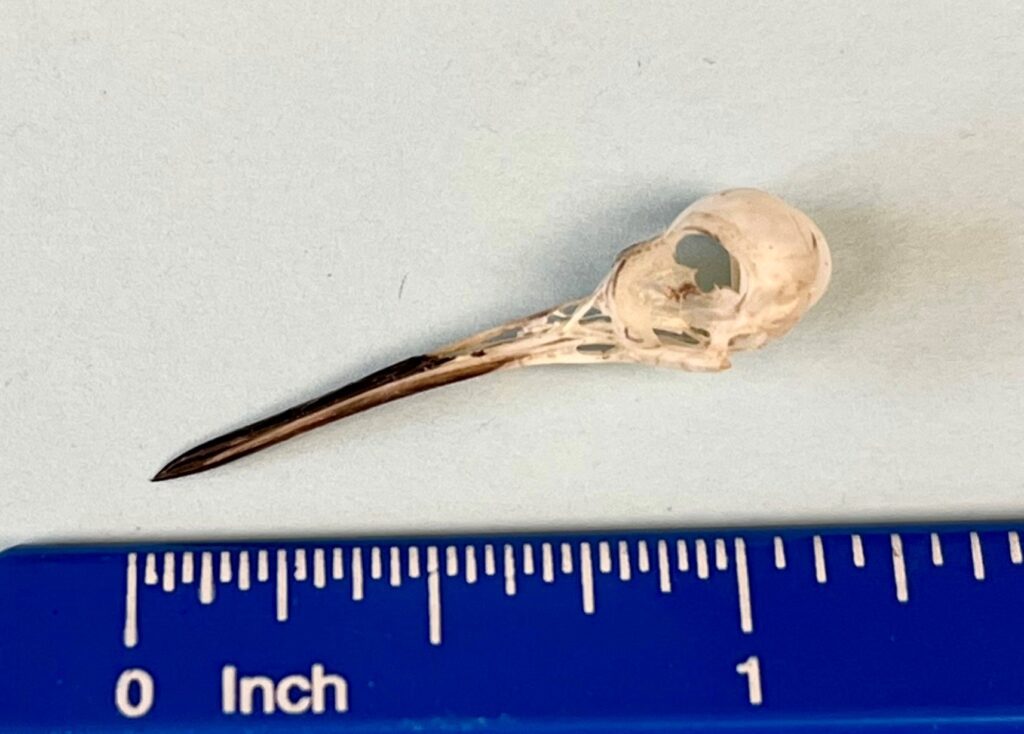by Patrick McShea

Banding hummingbirds is a routine procedure at Powdermill Avian Research Center (PARC). Ruby-throated Hummingbirds are common summer residents throughout western Pennsylvania, including the Ligonier Valley where PARC facilities occupy nearly 25 acres of diverse habitat within Powdermill Nature Reserve, the 2,200-acre field research station of Carnegie Museum of Natural History.
During the spring and fall migration seasons, Ruby-throated Hummingbirds are almost always on the top 10 list for highest numbers captured and banded. During the breeding season, they are proportionally represented among the various birds captured. PARC’s ornithologists open fine mesh nets before dawn and check them at regular intervals for several hours afterwards, carefully extracting the birds and bringing them to the lab for data collection, then safely releasing them to the wild without harm.

On a Friday morning in late May, the capture, examination, banding, and safe release of one of these tiny, iridescent, long-billed birds was remarkable because of the extra observers involved. Two dozen seventh grade students from West Hempfield Middle School, part of a larger, two-bus contingent participating in a day-long science-focused fieldtrip, were eyewitnesses to the multi-step process.
The wildlife encounter made such a strong collective impression on these students that two hours later, following a working demonstration of the flight tunnel used to evaluate bird-safe window glass, and lunchbreak on the Reserve’s Nature Center grounds, the background chatter of multiple conversations markedly diminished when I mentioned hummingbirds.
“We’ll start our hike shortly,” I announced to the group as they assembled in a forest clearing for the day’s concluding session. “But before we look at some plants along the trail and micro-habitats along the stream, we’re going talk more about hummingbirds.”

As a museum educator I frequently plan group opportunities for the close examination of authentic objects. In the case of the two-inch-long glass tube I then held aloft, an explanation of ground rules for the upcoming examination experience was required. The tube contained the skull of a Ruby-throated Hummingbird, and as I carefully removed the specimen and placed it in the palm of my right hand, I promised the students the same opportunity. “The skull can be safely exchanged by two transfer methods – gently dumping it from your open palm to your neighbor’s, or by picking it up by the beak and carefully placing it in the next person’s palm.”
Our collective sharing was also presented as a group challenge. I concluded the handling instructions with an explanation about how this activity is normally reserved for teachers, rather than students, and the disclosure that with less than a week left in the school year, I considered them as reputably more responsible eighth graders rather than the seventh-grade class listed on the fieldtrip schedule.
After placing the tiny skull in the palm of the student standing closest to me, I outlined for her and the waiting classmates a roughly 10-12 second procedure for an imaginative visual examination of the specimen. “Think about the bird you saw banded this morning. Consider the layers missing from the skull – the feathers, skin, muscles, and other tissues. Note especially, within the bone framework of the skull, the places where the eyes once were, space devoted to this creature’s sense of vision. And finally, before passing the skull to your neighbor, make a mental estimate of the space between the eyes, the nearly translucent bone case that contained the bird’s brain.”
Hand-to-hand circulation of the skull through the student group took a full seven minutes, time I spent relating information about Ruby-throated Hummingbirds from the Cornell Lab of Ornithology’s All About Birds website. Important points included how the species’ diet includes far more than nectar, with mosquitoes, gnats, fruit flies, small bees, and spiders being well documented prey items, and how six to ten days of construction work by the female bird results in an inch-deep, two-inch diameter, branch-top nest lined with plant down, held together with spider silk, and for concealment purposes, shingled with lichen chips. Migration was also addressed, with the statement that the hummingbird banded during the morning session might have just returned to western Pennsylvania after a winter spend as far south as Costa Rica.
“My estimate, when I look at the hummingbird skull,” I volunteered, “is that the bird’s brain is the size of a couple grains of rice. What I find amazing is how that tiny brain can steer the bird over or around an enormous obstacle between where we’re standing now and the forests of Costa Rica – the Gulf of Mexico.”
When the hummingbird skull, no worse for a carefully conducted activity’s wear, was safely stowed in my shirt pocket, the trail hike to the edge of Powdermill Run proceeded. A stand of trout lily, the mud chimney of a crayfish burrow, and the distinctive tree cavity chiseled by a Pileated Woodpecker were scenery highlights, but it was a discussion of Powdermill Run’s waters that reinforced the day’s hummingbird theme.
After a streamside question and answer session raised the level of understanding of aquatic food webs, and explanations were shared about how diverse invertebrate lifeforms are indicators of clean water, I brought up the question about where the flow in front of us was heading. Through question and response, one waterway supplying another, we assembled a continent-wide watershed, from Powdermill Run to the Gulf of Mexico, as one student called from the back of the group, “The territory crossed by a migrating hummingbird.”
Patrick McShea is an Educator at Carnegie Museum of Natural History.
Related Content
Tracking Migratory Flight in the Northeast
Ruffed Grouse or Scarlet Tanager: Debating the Pennsylvania State Bird
Carnegie Museum of Natural History Blog Citation Information
Blog author: McShea, PatrickPublication date: August 9, 2023
